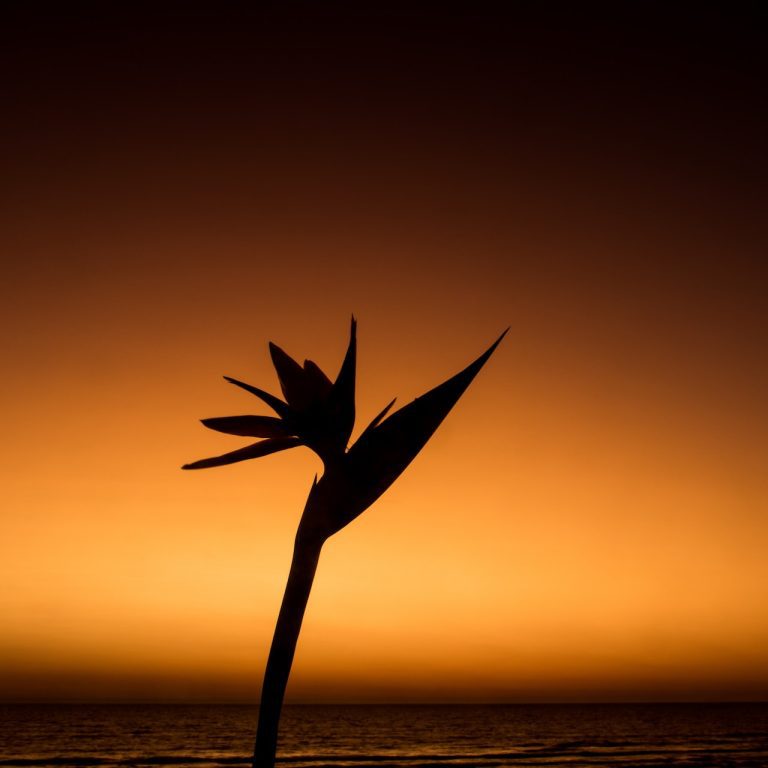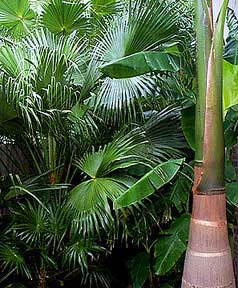Rhapis excelsa, from seed, grow painfully slow and are almost impossible to know what variety, form or cultivars one is growing until the plant is mature, even then it can become difficult in identification of these plants unless you know the seed and it’s parentage.
Rhapis excelsa can be divided into three groups according to leaf patterns; Solid green, striped and spotted, within these groups there are genealogical groups:
- Native: (plants grown in Japan for a long time) leaves tend to split into segments.
- Rakanchiku: (plants from southern China) leaves are narrow and split readily into segments, they resemble R. humilis to some extent.
- Imported: (plants imported from places other than Taiwan and southern China) these are a strange lot with various leaf characteristics, depending on place of origin.
- Taiwanchiku: (from Taiwan post WW2) leaves are large and wide and do not split easily.
Out of all this R. excelsa produces more male than female (two female plants, that come to mind are; R.e. ‘kodaruma’ and R.e. ‘taiheiden’ (a sport) these plants can be pollinated by the males with different characteristics to produce plants with varying degrees of leaf shapes, colors and size.
Are you confused yet? read on….
Plants are not always true to form, an example of this is a R.e. ‘fukuju’ that I have been growing, and is a solid green-form (most likely a native-group).
This plant, on one stem, has produced striped leaves, making it a R.e. ‘kotobuki’ yet all the other stems are still producing all green leaves. It is still considered a ‘fukuju’ until the pup or stem that is striped is removed and planted up by itself.
Most collectors or growers, rather than plant Rhapis from seed, which is slow (with an unreliable ID), take the pups (suckers if you will) from the mother plants and by propagating these shoots in this manner (which by the way is much faster), will nonetheless produce a Lady Palm with a real ID.
The difficulty in identifying them, and also touching on the difference between pot culture and outside plantings.
Characteristics of Kansochiku:
Stems
The trunks rarely grow higher than 3 meters (9 feet) and when planted in containers, is from one to three meters depending on age of plant and size of container, combined with growing conditions.
The diameter of the stems are from one inch (3 centimeters) such as the standard Rhapis, to almost two inches (5 centimeters) as in the case of the ‘Taiheidens’.
Leaves
The leaves never overlap but are slightly offset, this allows the plant to receive the most sunlight. Leaf in general is oval-shaped with the outside end more pointed than the inside.
The lengths of the leaves vary from about 10-40 centimeters (4-16 inches) and widths vary from 1.5-13 centimeters (1/2 -5 inches) with saw-tooth edges.
Leaves are dark green when grown in shade to a light green when grown with more sunlight. Leaves can either be shinny (glossy type) or with a dull flat finish.
There are over 100 Rhapis excelsa cultivars and each has somewhat different leaf characteristics, and that all adds to the confusion, of the proper identification of these palms.
Standard form, dwarfs, mini-dwarfs and sports
The standard form of Rhapis excelsa is what many of the cultivars are derived from, dwarfs and mini-dwarfs are a product of years of cultivation, mostly by the Japanese.
The method of cross pollination of plants and careful selection based upon the most desirable characteristics (size, leaf shape, color and/or variegation (strip or spot).
This takes many years and lots of plants! Sports are a group of palms that are found usually in field grown plants, mostly among the Rhapis excelsa ‘standard’, an example is R.e.’Taiheiden’.
Ideal temperature for maximum root growth is 15-60° C (60-87° F) and the best time to transplant, divide or remove pups is in the spring and fall.
Never plant a Rhapis in too large a pot for its roots, they do somewhat better when roots are slightly crowded. Never let plant completely dry out or be left soggy with wet feet, as root rot will soon kill your Lady palm.
Rhapis excelsa
The Rhapis Excelsa is hardy to about 20° F (-7° C) and is somewhat more root hardy. Leaves start to show damage at about 25° F so if temperatures are in the forecast to fall within, or below this level, one should take action to protect them.
In the 1980s Texas saw two big freezes, one in ’83 and again in ’89, temperatures went down into the teens and in one year temperatures remained below freezing for 72 hours. Most all the Rhapis were killed to the ground but many regrew form their roots and quickly reestablished themselves with vengeance.
Lady palms once established are a tough, hardy bunch of gals and they should be used more often in landscape plantings. They do well growing under trees, overhangs and against east (receiving only morning light) and north sides of building, homes, and walls.
They can take morning light even here in South Texas, but do much better in a shaded but with some (bright filtered light) growing area. They also make wonderful house plants and there are many dwarf verities to choose from…
Disease and Insect Problems
Kansochiku (Rhapis excelsa), are among the fortunate of the ornamental plants as they are less susceptible to diseases and insect damage.
Although plants can be damaged by noxious insects such as mites and scale and the lack of fresh air, poor growing conditions and proper gardening hygiene can cause diseases to set in.
One must take safeguards against insect and disease by a careful inspection of plants at least once a week.
Brown spot is caused by high humidity and low temperatures, which shows up usually on the older leaves as brown spots. This can spread quite rapidly to other plants especially if grouped too close together. Leaves should be treated with a fungicide such as Banrot or Captan at monthly intervals and be sure to treat all other plants as well.
Root rot is caused by poor drainage or by excessive watering and fertilizing. Symptoms of root rot include drooping leaves, change in the color of leaves, as tips turn a reddish brown and the loss of the plants vitality.
Immediate action must be taken, by removing plant from pot, wash the roots thoroughly with fresh clean water, remove rooting roots, and re-plant in a well draining potting medium. Keep plant out of full sun light, provide good air ventilation and do not fertilize until plant shows signs of recovery.







